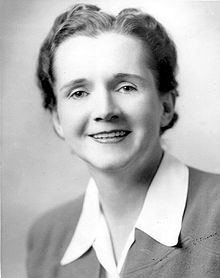
Rachel Louise Carson (May 27, 1907 – April 14, 1964) was an American marine biologist and nature writer whose writings are credited with advancing the global environmental movement.
Carson started her career as a biologist in the U.S. Bureau of Fisheries, and became a full-time nature writer in the 1950s. Her widely praised 1951 bestseller The Sea Around Us won her financial security and recognition as a gifted writer. Her next book, The Edge of the Sea, and the republished version of her first book, Under the Sea Wind, were also bestsellers. Together, her sea trilogy explores the whole of ocean life, from the shores to the surface to the deep sea.
In the late 1950s, Carson turned her attention to conservation and the environmental problems caused by synthetic pesticides. The result was Silent Spring (1962), which brought environmental concerns to an unprecedented portion of the American public. Silent Spring spurred a reversal in national pesticide policy—leading to a nationwide ban on DDT and other pesticides—and the grassroots environmental movement the book inspired led to the creation of the Environmental Protection Agency. Carson was posthumously awarded the Presidential Medal of Freedom by Jimmy Carter.
Read more...
 Jaime Lerner (born December 17, 1937) was governor of the state of Paraná, in southern Brazil. He is renowned as an architect and urban planner, having been mayor of Curitiba, capital of Paraná, three times (1971–75, 1979–84 and 1989–92). In 1994, Lerner was elected governor of Paraná, and was reelected in 1998. Jaime Lerner (born December 17, 1937) was governor of the state of Paraná, in southern Brazil. He is renowned as an architect and urban planner, having been mayor of Curitiba, capital of Paraná, three times (1971–75, 1979–84 and 1989–92). In 1994, Lerner was elected governor of Paraná, and was reelected in 1998.
Early life
Lerner was born to a Jewish family originally from Poland in Curitiba. He graduated from the Escola de Arquitetura da Universidade Federal do Paraná; (Architecture School of the Federal University of Paraná) in 1964. In 1965, he helped create the Instituto de Pesquisa e Planejamento Urbano de Curitiba (Institute of Urban Planning and Research of Curitiba, also known as IPPUC) and participated in the design of the Curitiba Master Plan.
As Mayor of Curitiba
In 1988, Jaime Lerner announced his candidacy for mayor of Curitiba with only 12 days remaining before the election. During his first term, Lerner implemented the Rede Integrada de Transporte (also called Bus Rapid Transit), and continued to implement a host of social, ecological, and urban reforms during his ensuing terms as mayor.
Read more...
Biography
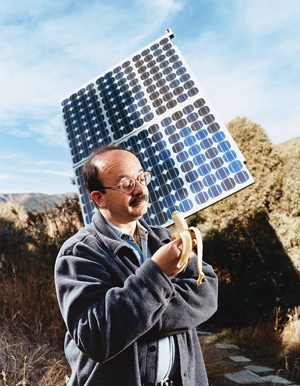
Amory Bloch Lovins (born November 13, 1947 in Washington, DC)[3] is Chairman and Chief Scientist of the Rocky Mountain Institute. For four decades he has worked in energy policy and related areas.
Lovins worked professionally as an environmentalist in the 1970s and since then as an analyst of a "soft energy path" for the United States and other nations. He has promoted energy efficiency, the use of renewable energy sources, and the generation of energy at or near the site where the energy is actually used. Lovins has also advocated a "negawatt revolution" arguing that utility customers don’t want kilowatt-hours of electricity; they want energy services. In the 1990s, his work with Rocky Mountain Institute included the design of an ultra-efficient automobile, the Hypercar.
Lovins has received ten honorary doctorates and won many awards. He has provided expert testimony in eight countries, briefed 19 heads of state, and published 29 books. These books include Winning the Oil Endgame, Small is Profitable, Factor Four, and Natural Capitalism. In 2009, Time magazine named Lovins as one of the world's 100 most influential people.
Early history
Lovins spent much of his youth in Silver Spring, Maryland and in Amherst, Massachusetts. In 1964, Lovins entered Harvard College. After two years there, he transferred in 1967 to Magdalen College, Oxford, England, where he studied physics and other topics. In 1969 he became a Junior Research Fellow in Oxford’s Merton College, where he received an Oxford master of arts (M.A.) as a result of becoming a university don. However, the University would not allow him to pursue a doctorate in energy, as it was two years before the 1973 oil embargo, and energy was not yet considered an academic subject. Lovins resigned his Fellowship and moved to London to pursue his energy work. He moved back to the U.S. in 1981 and settled in Western Colorado in 1982.[4]
In 1979 he married L. Hunter Sheldon, a lawyer, forester, and social scientist. Hunter received her undergraduate degree in sociology and political studies from Pitzer College, and her J.D. from Loyola University's School of Law. They separated in 1989 and divorced in 1999.[5] In 2007, he married Judy Hill Lovins, a fine-art landscape photographer.
Read more...
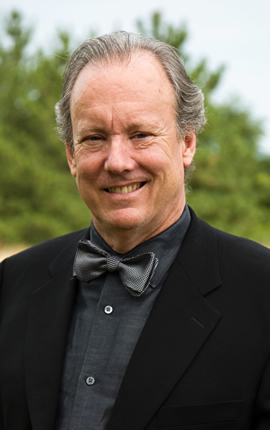 William Andrews McDonough is an American architect, founding principal of William McDonough + Partners, co-founder of McDonough Braungart Design Chemistry (MBDC) with German chemist Michael Braungart as well as co-author of 'Cradle to Cradle: Remaking the Way We Make Things also with Braungart.[1] McDonough's career is focused on designing environmentally sustainable buildings and transforming industrial manufacturing processes. William Andrews McDonough is an American architect, founding principal of William McDonough + Partners, co-founder of McDonough Braungart Design Chemistry (MBDC) with German chemist Michael Braungart as well as co-author of 'Cradle to Cradle: Remaking the Way We Make Things also with Braungart.[1] McDonough's career is focused on designing environmentally sustainable buildings and transforming industrial manufacturing processes.
Biography
McDonough was born in Tokyo, the son of an American Seagram's executive, and trained at Dartmouth College and Yale University.[2] In 1981 McDonough founded his architectural practice,[3] and his first major commission was the 1984 Environmental Defense Fund Headquarters.[4] The EDF's requirement of good indoor air quality in the structure exposed McDonough to the need for sustainable development.[5]
McDonough's practice is located in Charlottesville, Virginia, with a small office in San Francisco, California and Amsterdam, the Netherlands.[6] McDonough moved his practice from New York City to Charlottesville in 1994, when he was appointed as the Dean of the School of Architecture at the University of Virginia.[7] He relinquished this position in 1999 to focus on expanding his professional practice.
Read more...
 James Lovelock, CH, CBE, FRS (born 26 July 1919) is an independent scientist, environmentalist and futurologist who lives in Devon, England. He is best known for proposing the Gaia hypothesis, which postulates that the biosphere is a self-regulating entity with the capacity to keep our planet healthy by controlling the chemical and physical environment. James Lovelock, CH, CBE, FRS (born 26 July 1919) is an independent scientist, environmentalist and futurologist who lives in Devon, England. He is best known for proposing the Gaia hypothesis, which postulates that the biosphere is a self-regulating entity with the capacity to keep our planet healthy by controlling the chemical and physical environment.
Biography
James Ephraim Lovelock was born in Letchworth Garden City in Hertfordshire, England, but moved to London where he was, by his own account, an unhappy pupil at Strand School.[1] He studied chemistry at the University of Manchester, before taking up a Medical Research Council post at the Institute for Medical Research in London.[2] His student status enabled temporary deferment of military service during the Second World War, but he registered as a conscientious objector.[3] He later abandoned this position in the light of Nazi atrocities and tried to enlist for war service, but was told that his medical research was too valuable for this to be considered.
In 1948 Lovelock received a Ph.D. degree in medicine at the London School of Hygiene and Tropical Medicine. Within the United States he has conducted research at Yale, Baylor College of Medicine, and Harvard University.[2]
Read more...
 David Holmgren (born 1955) is an ecologist, ecological design engineer and writer. He is perhaps most well known as co-originator of the permaculture concept with Bill Mollison. Through the spread of permaculture around the world, his environmental principles have exerted a global influence. David Holmgren (born 1955) is an ecologist, ecological design engineer and writer. He is perhaps most well known as co-originator of the permaculture concept with Bill Mollison. Through the spread of permaculture around the world, his environmental principles have exerted a global influence.
Life and work
Holmgren was born in the state of Western Australia. He studied at the College of Advanced Education in Hobart, Tasmania, where in 1972 he met Bill Mollison, who was then a lecturer at the University of Tasmania. The two found they shared a strong interest in the relationship between human and natural systems. Their wide-ranging conversations and gardening experiences encouraged Holmgren to write the manuscript that was to be published in 1978 as Permaculture One.
- 'I wrote the manuscript, which was based partly on our constant discussions and on our practical working together in the garden and on our visits to other sites in Tasmania... I used this manuscript as my primary reference for my thesis, which I submitted and was passed in 1976.'[1]
The book was a mixture of insights relating to agriculture, landscape architecture and ecology. The relationships between these disciplines were elaborated into a novel design system termed permaculture. Although the title clearly owes something to Russell Smith's Tree Crops: A Permanent Agriculture (first published 1929), Holmgren's chief theoretical inspiration was the energy dynamics of American ecologist Howard T. Odum (Environment, Power and Society, 1971). The same book was promoted by David M. Scienceman as a platform for a scientific political party.
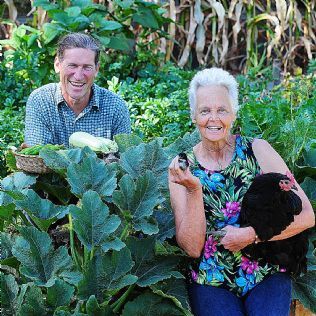 According to Holmgren, According to Holmgren,
- 'The word permaculture was coined by Bill Mollison and myself in the mid-1970s to describe an "integrated, evolving system of perennial or self-perpetuating plant and animal species useful to man". A more current definition of permaculture, which reflects the expansion of focus implicit in Permaculture One, is "Consciously designed landscapes which mimic the patterns and relationships found in nature, while yielding an abundance of food, fibre and energy for provision of local needs". People, their buildings and the ways they organise themselves are central to permaculture. Thus the permaculture vision of permanent (sustainable) agriculture has evolved into one of permanent (sustainable) culture.' [2]
Permaculture One was far more successful than anticipated, as it seemed to meet a need of the emerging environmentalist counterculture looking for something positive and substantial to align with. It was published in five languages, but is now out of print and of mainly historical value, having been superseded and refined in later works.
Read more...
 Masanobu Fukuoka, the Japanese farmer/philosopher from Shikoku Island, and author of The One-Straw Revolution, passed away on August 16, 2008 at the age of 95. He continued to farm and give lectures until just a few years before his death. He had been in poor health since October 2007, and in August of 2008 he asked his doctor to discontinue treatment. He passed away peacefully at his home a week later during the O-bon festival. O-bon, after New Years, is the most important Japanese holiday. It is when the ancestors come back to earth for three days to visit the living. It is a happy time. Villagers tend to the graves, families relax, visit and reminisce as children play together in the summer sun. On the evening of the third night the ancestors go back with a sendoff of songs and fireworks. Fukuoka-sensei died on the third day of O-bon. Masanobu Fukuoka, the Japanese farmer/philosopher from Shikoku Island, and author of The One-Straw Revolution, passed away on August 16, 2008 at the age of 95. He continued to farm and give lectures until just a few years before his death. He had been in poor health since October 2007, and in August of 2008 he asked his doctor to discontinue treatment. He passed away peacefully at his home a week later during the O-bon festival. O-bon, after New Years, is the most important Japanese holiday. It is when the ancestors come back to earth for three days to visit the living. It is a happy time. Villagers tend to the graves, families relax, visit and reminisce as children play together in the summer sun. On the evening of the third night the ancestors go back with a sendoff of songs and fireworks. Fukuoka-sensei died on the third day of O-bon.
In 1988, Masanobu Fukuoka recieved The 1988 Ramon Magsaysay Award For Public Service. The following biography is excerpted from the award presentation on August 31, 1988 in Manila, Philippines:
Masanobu Fukuoka was born on the Japanese island of Shikoku on 2 February 1913. Iyo, his birthplace, is a small town on the west coast, sixteen miles from the city of Matsuyama. His family had been settled there for hundreds of years. On Iyo's hillsides overlooking Matsuyama, his father, Kameichi Fukuoka, cultivated mandarin oranges (tangerines). These orchards, combined with extensive rice lands below, made Kameichi the largest landowner in the area. Kameichi was an educated man, having completed eight years of schooling, which was exceptional for his day. Repeatedly the local leaders selected him mayor.
Fukuoka’s mother, Sachie Isshiki, was of Samurai descent and also well-educated. She was gentle, whereas his father was strict and permitted no luxuries in the household. Even so, Fukuoka remembers a childhood of ease. Tenants tilled the family rice lands. As the second child of six and eldest son, his only chore was to gather wood after school each day.
The family was Buddhist but was tolerant toward Christianity, which had penetrated the Iyo region long before; as a boy Fukuoka was accustomed to seeing Christian symbols incorporated into household Shinto shrines. Years later, he would send two of his daughters to missionary schools.
 Fukuoka’s own education began in Iyo's local elementary school, but for middle and high school he had to travel to Matsuyama. Thus, for many years he rode his bicycle daily to Iyo Station, took the train to the city, and went the rest of the way on foot — about half an hour's walk. He claims to have been an inferior student who infuriated his teachers. (One day, in a rage over his misbehavior, the music teacher slammed down the top of the village's only organ so hard that it broke.) Although lessons did not interest him, the boy was impressed by the advice of his literature teacher who urged each student to make five fast friends during his lifetime so that there would be five people to weep for him when he died. Fukuoka’s own education began in Iyo's local elementary school, but for middle and high school he had to travel to Matsuyama. Thus, for many years he rode his bicycle daily to Iyo Station, took the train to the city, and went the rest of the way on foot — about half an hour's walk. He claims to have been an inferior student who infuriated his teachers. (One day, in a rage over his misbehavior, the music teacher slammed down the top of the village's only organ so hard that it broke.) Although lessons did not interest him, the boy was impressed by the advice of his literature teacher who urged each student to make five fast friends during his lifetime so that there would be five people to weep for him when he died.
As it was expected that Fukuoka would inherit the family farm, his father sent him for higher education to Gifu Agricultural College, near Nagoya, on the main island of Honshu. Gifu was a three-year state college where students learned modern techniques for largescale farming. Once again, Fukuoka was an indifferent student who preferred to spend his time horseback riding and "fooling around"; student life was generally idyllic and irresponsible. However, a feeling of impending crisis swept the school in 1932 when Japan annexed Manchuria. Fukuoka and his fellow students detested the intensified military training they were now obliged to undergo.
Read more...
 Bruce Charles (Bill) Mollison (b 1928), founder of Permaculture, was born in Stanley, and after leaving school aged fourteen, worked as a baker, fisherman, firewood splitter, researcher for CSIRO and the Inland Fisheries Commission, and lecturer in Psychology at the University of Tasmania. In the 1970s, Mollison researched and published extensive genealogies of Tasmanian Aborigines, enabling many to prove their lineage, and assisting the emergence of the Tasmanian Aboriginal movement. Bruce Charles (Bill) Mollison (b 1928), founder of Permaculture, was born in Stanley, and after leaving school aged fourteen, worked as a baker, fisherman, firewood splitter, researcher for CSIRO and the Inland Fisheries Commission, and lecturer in Psychology at the University of Tasmania. In the 1970s, Mollison researched and published extensive genealogies of Tasmanian Aborigines, enabling many to prove their lineage, and assisting the emergence of the Tasmanian Aboriginal movement.
At much the same time, with David Holmgren Mollison developed the idea of Permaculture, the harmonious integration of landscape and people by establishing agriculturally productive systems with the diversity and stability of natural ecosystems. Mollison wrote many books about Permaculture, founded the Permaculture Institute (1978), and addressed audiences around the world. Informal, energetic and engaging, Mollison was extremely successful and Permaculture gained popularity worldwide, though this later declined somewhat.
Bibliography:
Permaculture One: A Perennial Agriculture for Human Settlements (with David Holmgren, Trasworld Publishers, 1978) ISBN 978-0938240006
Permaculture Two: Practical Design for Town and Country in Permanent Agriculture (Tagari Publications, 1979)
Permaculture - A Designer's Manual (1988) ISBN 978-0908228010
Introduction to Permaculture (1991, Revised 1997) ISBN 978-0908228089
The Permaculture Book of Ferment and Human Nutrition (1993, Revised 1997) ISBN 978-0908228065
Travels in Dreams: An Autobiography (1996) ISBN 978-0908228119
The Permaculture Way: Practical Steps To Create A Self-Sustaining World, with Graham Bell (2005) ISBN 978-1856230285
Smart Permaculture Design, with Jenny Allen (2006) ISBN 978-1877069178
|
|
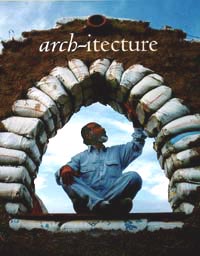 Nader Khalili (1936-2008) is the world-renowned Iranian-American architect, author, humanitarian, teacher, and innovator of the Geltaftan Earth-and-Fire system known as Ceramic Houses, and of the Superadobe construction system. Khalili received his philosophy and architectural education in Iran, Turkey, and the United States.
Nader Khalili (1936-2008) is the world-renowned Iranian-American architect, author, humanitarian, teacher, and innovator of the Geltaftan Earth-and-Fire system known as Ceramic Houses, and of the Superadobe construction system. Khalili received his philosophy and architectural education in Iran, Turkey, and the United States.


 Biographies
Biographies



 Jaime Lerner (born December 17, 1937) was governor of the state of Paraná, in southern Brazil. He is renowned as an architect and urban planner, having been mayor of Curitiba, capital of Paraná, three times (1971–75, 1979–84 and 1989–92). In 1994, Lerner was elected governor of Paraná, and was reelected in 1998.
Jaime Lerner (born December 17, 1937) was governor of the state of Paraná, in southern Brazil. He is renowned as an architect and urban planner, having been mayor of Curitiba, capital of Paraná, three times (1971–75, 1979–84 and 1989–92). In 1994, Lerner was elected governor of Paraná, and was reelected in 1998.
 William Andrews McDonough is an American architect, founding principal of
William Andrews McDonough is an American architect, founding principal of  James Lovelock,
James Lovelock,  David Holmgren (born 1955) is an ecologist, ecological design engineer and writer. He is perhaps most well known as co-originator of the permaculture concept with Bill Mollison. Through the spread of permaculture around the world, his environmental principles have exerted a global influence.
David Holmgren (born 1955) is an ecologist, ecological design engineer and writer. He is perhaps most well known as co-originator of the permaculture concept with Bill Mollison. Through the spread of permaculture around the world, his environmental principles have exerted a global influence.
 Masanobu Fukuoka
Masanobu Fukuoka Fukuoka’s own education began in Iyo's local elementary school, but for middle and high school he had to travel to Matsuyama. Thus, for many years he rode his bicycle daily to Iyo Station, took the train to the city, and went the rest of the way on foot — about half an hour's walk. He claims to have been an inferior student who infuriated his teachers. (One day, in a rage over his misbehavior, the music teacher slammed down the top of the village's only organ so hard that it broke.) Although lessons did not interest him, the boy was impressed by the advice of his literature teacher who urged each student to make five fast friends during his lifetime so that there would be five people to weep for him when he died.
Fukuoka’s own education began in Iyo's local elementary school, but for middle and high school he had to travel to Matsuyama. Thus, for many years he rode his bicycle daily to Iyo Station, took the train to the city, and went the rest of the way on foot — about half an hour's walk. He claims to have been an inferior student who infuriated his teachers. (One day, in a rage over his misbehavior, the music teacher slammed down the top of the village's only organ so hard that it broke.) Although lessons did not interest him, the boy was impressed by the advice of his literature teacher who urged each student to make five fast friends during his lifetime so that there would be five people to weep for him when he died. Bruce Charles (Bill) Mollison (b 1928), founder of Permaculture, was born in Stanley, and after leaving school aged fourteen, worked as a baker, fisherman, firewood splitter, researcher for CSIRO and the Inland Fisheries Commission, and lecturer in Psychology at the University of Tasmania. In the 1970s, Mollison researched and published extensive genealogies of Tasmanian Aborigines, enabling many to prove their lineage, and assisting the emergence of the Tasmanian Aboriginal movement.
Bruce Charles (Bill) Mollison (b 1928), founder of Permaculture, was born in Stanley, and after leaving school aged fourteen, worked as a baker, fisherman, firewood splitter, researcher for CSIRO and the Inland Fisheries Commission, and lecturer in Psychology at the University of Tasmania. In the 1970s, Mollison researched and published extensive genealogies of Tasmanian Aborigines, enabling many to prove their lineage, and assisting the emergence of the Tasmanian Aboriginal movement.

